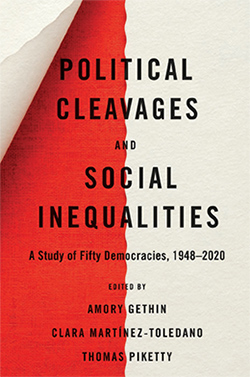The book
Who votes for whom and why? Why has growing inequality in many parts of the world not led to renewed class-based conflicts, and seems instead to have come with the emergence of new divides over identity and integration? News analysts, scholars, and citizens interested in exploring those questions inevitably lack relevant data, in particular the kinds of data that establish historical and international context. Political Cleavages and Social Inequalities provides the missing empirical background, collecting and examining a treasure trove of information on the dynamics of polarization in modern democracies.
The chapters draw on a unique set of surveys conducted between 1948 and 2020 in fifty countries on five continents, analyzing the links between voters’ political preferences and socioeconomic characteristics, such as income, education, wealth, occupation, religion, ethnicity, age, and gender. This analysis sheds new light on how political movements succeed in coalescing multiple interests and identities in contemporary democracies. It also helps us understand the conditions under which conflicts over inequality become politically salient, as well as the similarities and constraints of voters supporting ethnonationalist politicians like Narendra Modi, Jair Bolsonaro, Marine Le Pen, and Donald Trump.
The chapters draw on a unique set of surveys conducted between 1948 and 2020 in fifty countries on five continents, analyzing the links between voters’ political preferences and socioeconomic characteristics, such as income, education, wealth, occupation, religion, ethnicity, age, and gender. This analysis sheds new light on how political movements succeed in coalescing multiple interests and identities in contemporary democracies. It also helps us understand the conditions under which conflicts over inequality become politically salient, as well as the similarities and constraints of voters supporting ethnonationalist politicians like Narendra Modi, Jair Bolsonaro, Marine Le Pen, and Donald Trump.
The project
The World Political Cleavages and Inequality Database (WPID) is the result of a collaborative research program involving about twenty researchers all around the world. The central aim is to provide open and convenient access to the most extensive available dataset on the structure of political cleavages and social inequalities in electoral democracies, located on the five continents, from the mid-20th century to the present.
The database relies on a quasi-unique source: electoral surveys conducted in a number of countries that have organized plural elections since the end of World War II. These surveys, carried out on representative samples of generally a few thousand voters, most often in the days or weeks following the corresponding election, have collected information on both respondents’ electoral behaviors and their socioeconomic characteristics. In spite of their imperfections, they constitute one of the most precious sources at our disposal to study the relationships between the structure of political cleavages and social inequalities. The electoral surveys have been harmonized in such a way as to document in a systematic manner how electoral choices vary according to social attributes such as income, education, occupation, gender, age, national origin, or ethnoreligious identity.
We hope first and foremost that this database will contribute to inspire further research on these questions among the social sciences research community, and will allow journalists and other interested citizens to better understand the interaction between political cleavages and social inequalities in comparative and historical perspective.
The database relies on a quasi-unique source: electoral surveys conducted in a number of countries that have organized plural elections since the end of World War II. These surveys, carried out on representative samples of generally a few thousand voters, most often in the days or weeks following the corresponding election, have collected information on both respondents’ electoral behaviors and their socioeconomic characteristics. In spite of their imperfections, they constitute one of the most precious sources at our disposal to study the relationships between the structure of political cleavages and social inequalities. The electoral surveys have been harmonized in such a way as to document in a systematic manner how electoral choices vary according to social attributes such as income, education, occupation, gender, age, national origin, or ethnoreligious identity.
We hope first and foremost that this database will contribute to inspire further research on these questions among the social sciences research community, and will allow journalists and other interested citizens to better understand the interaction between political cleavages and social inequalities in comparative and historical perspective.
News
New Data on Eastern European Countries
January 21, 2025 | WPID
The WPID has been updated to cover four additional Eastern European countries, thanks to the work of Kamil Krzyszczyk. Explore the data Read the underlying research
New Data for France 2022
September 1, 2024 | WPID
The WPID has been updated to cover the 2022 French presidential elections, using the 2022 French Electoral Study survey. Explore the data
Political Cleavages and Social Inequalities Now Available in Greek
July 7, 2024 | WID.world
The Greek translation of Political Cleavages and Social Inequalities has been published. Continue reading
Major Update of the WPID
February 9, 2024 | The Guardian
The WPID has been updated, with new data for 18 countries over 2019-2022! Continue reading
Political Cleavages and Social Inequalities Featured in the Financial Times
February 9, 2024 | The Economist
Why are young people deserting conservatism in Britain but nowhere else? Shocks thought to be worldwide have hit Britain’s young adults harder than most. Continue reading
